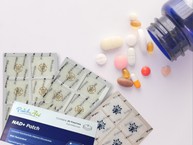Some women have easy cycles, and some women…well…don’t. That’s why there’s the PatchAid Easy Cycle Patch.* It has a unique formula of ingredients designed to relieve common symptoms from the menstrual cycle, including pain.
Period pain is just one of many symptoms that some women experience all or most months. Others can include bloating, trouble sleeping, and mood swings. Period pain can come from contractions as the uterus gets ready to shed the lining when you do not get pregnant on that cycle. It can be unnoticeable, or it can be uncomfortable, or it can be so severe that it can get in the way of regular daily activities.
But there is hope. Here are six ways to get relief from period pain. Just remember to talk to your healthcare provider if you have worrisome symptoms and before taking any medications or supplements. Also as about the PatchAid Easy Cycle Patch and whether it may help you.*
Get some exercise.
It can seem hard to get moving when you’re in pain, but it can be worth the effort. Exercising can cause your body to release natural chemicals called endorphins. These endorphins reduce the sensation of pain that you may feel. They can also help reduce mood swings and irritability as they make you feel happier. In addition, exercising can help reduce stress, which is another way to reduce the feelings of pain.
When you exercise, it’s okay to take it slow. There’s no need to push yourself unless you feel like it. You can also benefit from exercising outside in the sunshine if possible. The natural light can also boost your mood.
Eat well.
Eating good nutrients and avoiding less healthy foods may make a difference in period pain. Your body needs certain nutrients to relax muscles, and muscle relaxation can help relieve cramps. In addition, certain nutrients, such as B vitamins and iron, are needed for normal energy metabolism, which is necessary for optimal energy. That can be welcome if you’re fighting period fatigue!
These are some foods that provide essential vitamins and minerals for normal muscle relaxation as well as energy production and metabolism.
- Vegetables, such as eggplant, spinach, broccoli, carrots, onions, zucchini, and tomatoes.
- Whole grains, such as oatmeal, popcorn, shredded wheat, whole-wheat pasta, whole-grain bread and English muffins, and brown rice.
- Legumes, such as beans, lentils, and split peas.
- Low-fat dairy products, such as skim milk, plain yogurt, low-fat cottage cheese, and low-fat cheese.
- Peanuts, seeds, and nuts, such as macadamia nuts, hazelnuts, almonds, cashews, and pistachios.
- Fish.
It’s also important to avoid foods that can make you feel irritable or bloated. Sugary foods, fatty foods, high-sodium or salty foods, and foods with a lot of refined starches may be worth limiting, especially during certain times of the month. These are some examples.
- Fried foods
- Fast food
- Candy and sweets
- Baked goods
- Canned soup
Reduce stress.
Stress can make pain feel worse. Managing stress better may help reduce the sensation of pain that you feel during your period. It may not be possible to reduce the amount of stressors in your life very much, but you may be able to manage them better so that they have less of a negative effect on you and your period pain.
These are some common stress management techniques.
- Talking to friends.
- Exercising.
- Playing an instrument.
- Listening to music.
- Progressive muscle relaxation.
- Practicing yoga.
Apply heat.
Heat can increase blood flow to the area and help relax the muscles, which can reduce period pain. Using a heating pad is a standard approach. If you’re on the go, heat patches are available to stick onto the affected area.
Taking a warm bath can not only help manage pain by providing heat, but it can also help reduce stress. You can even try a bubble bath or another type of bath that has an aromatherapy benefit to reduce stress.
Take medication.
Pain relievers are easy to come by and they can work quickly. NSAIDS help reduce inflammation along with blocking the sensation of pain. Examples include ibuprofen and naproxen. Acetaminophen blocks pain, but doesn’t address inflammation. The effects may be less dramatic or shorter lived.
Ask your doctor which medications may be right for you, and be sure to get clear instructions on how to use them safely. Even over-the-counter medications can have serious side effects.
Use a vitamin patch.*
The PatchAid Easy Cycle Patch has essential vitamins and minerals such as vitamins C and E, which are antioxidants, iron and zinc, which are needed for immune function, and calcium and magnesium, which are essential for normal muscle function.* It also has antioxidants and black cohosh, as well as dong quai, which have been used for a long time to reduce symptoms of PMS and period pain.*
It’s easy to use the PatchAid Easy Cycle Patch, and that can be important during this time of the month when you may not be at your best in terms of mental focus or physical energy. You can use it day or night, at your convenience, and just stick it onto an area of skin that smooth and clean.
Period pain isn’t fun, and it is real, but there are some steps you can take to get relief. Along with taking medications if your doctor recommends them, and living a generally healthy lifestyle for mind and body, the PatchAid Easy Cycle Patch is a strategy for reducing period pain and other symptoms.* Be sure to talk to your doctor if you have severe symptoms related to your cycle, and also ask before taking any medications or nutritional supplements.
*The Food and Drug Administration has not evaluated these statements. PatchAid patches are not intended to diagnose, treat, cure or prevent any disease. Anyone with a medical condition should seek the advice of a licensed medical practitioner. Individual results may vary.







